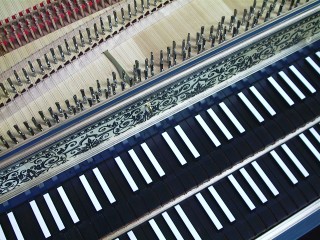Technical Library
RESOURCES II: First encounter with the harpsichord
Entire Contents Copyright © 2006 CBHTechnical LibraryRESOURCES II: First encounter with the harpsichord Entire Contents Copyright © 2006 CBH |
First encounter with the historic harpsichord …
Harpsichords don’t bite, so the intention of this page is to help you
from feeling overwhelmed on your first experience seated at the controls of
an historic harpsichord.
You might first like to be aware of how the jack action of the harpsichord works, then return to this page.
Any harpsichord usually has a minimum of two sets of strings called choirs, able to be varied at the will of the player by adjusting the registers. This can be accomplished in several ways, usually by registers piercing the cheek (Flemish instruments), stop levers piercing the nameboard (French), stop levers on the wrestplank (German), or just using the top jack to lever the whole register ON or OFF (Italian).
If you hear middle c' when you play middle c', you are playing as usually expected—on at least one unison or 8´ choir. A 4´ choir plucks shorter strings and sounds an octave higher.
 |
| Ruckers-style traditional registers piercing cheek |
The original Flemish instruments usually had their register ends piercing the cheek, or right hand side of the harpsichord. The upper surface of the register ends would be covered with bone, and supplied with an ornamental tassel or leather thong. Given a suitable break in the music, the player could reach around the side of the harpsichord, grasp the appropriate register end and push or pull it to bring sets of strings in or out of gear and radically change the tone.
In the original Ruckers disposition of 8´ + 4´, the closest register to the player is the 8´ choir. The jacks of that choir face right, so it is turned ON when the register is pulled out, and OFF when the register is pushed in. Go gently, because the movement between ON and OFF positions is probably only 2mm (less than 1/8˝).
The 4´ or octave choir plucks to the left, and is operated by the back register of the two. This choir is turned ON when its register is pushed in.
Both choirs are playing together when the front register is pulled out, and the back register pushed in.
To play the basic voice of this type of instrument—the single unison—both registers should be pulled out.
There might also be a buff stop on this type of harpsichord. This is a row of leather or cloth pads which can press against the end of the unison strings, muting them and giving an attractive gut string sort of effect. The buff could be operated either by its batten piercing the cheek just in front of the register ends themselves, or else with a knob directly connected to the batten and accessible by reaching over one or either end of the wrestplank.
Some Flemish Single instruments are made today with two 8´ choirs instead
of with the 4´.
 |
| Franco-Flemish Double, showing buff stop lever in middle of nameboard |
Larger—particularly double-manual—instruments are usually supplied with stop levers for the greater convenience of the player. The stop levers either penetrate the keywell, piercing the nameboard at both ends level with the wrestplank, or are mounted on top of the wrestplank either end of the tuning pins.
The upper keyboard plays the front 8´ choir at all times, the closest jacks to the player. This choir is usually unaffected by the position of the stop levers, or whether or not it is COUPLED to the lower.
Most makers today put the lever for the back 8´ choir on the left. This choir plays from the bottom keyboard, and is ON when the lever is pushed to the right. There is often little need to ever turn this choir OFF. Again, go gently because the movement between ON and OFF positions is not great.
The 4´ choir also plays from the bottom keyboard, and its lever is usually found at the right hand side of the keywell so it can be operated quickly by the right hand, given sufficient gap in the music. Its ON position is to the right.
The usual playing position for this type of harpsichord is with both hands on the lower keyboard, with both keyboards coupled to give the richer sound of two unison choirs together. Most instruments accomplish this with a shove coupler: The upper keyboard end blocks are either provided with knobs, or shaped to allow the hands to grasp them at both ends. To COUPLE the keyboards, gently push the upper keyboard away from you about 12mm (1/2˝) . UNCOUPLE by gently pulling the upper keyboard towards you. While it is possible to couple the keyboards while playing on the upper, never try to couple while you have notes on the lower keyboard depressed.
For convenience, the buff stop on larger instruments like this might be operated by a lever in the middle of the nameboard. If the buff is intended by the maker to mute the longer, back 8´ strings of the lower keyboard, it will be ON when the lever is moved to the right. This gives the best sound, but many makers put the buff stop on the front 8´ choir instead, so it affects the upper keyboard. This does allow the change to made more rapidly because the player does not need to UNCOUPLE the keyboards. In this instance, the buff will be ON when the lever is moved to the left.
| Technical Library overview | |
| Harpsichords Australia Home Page |